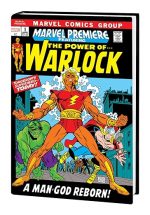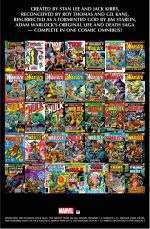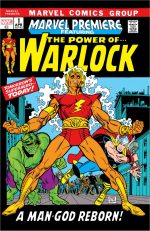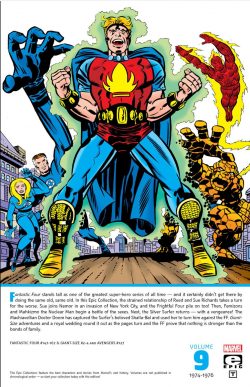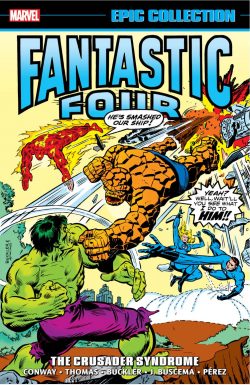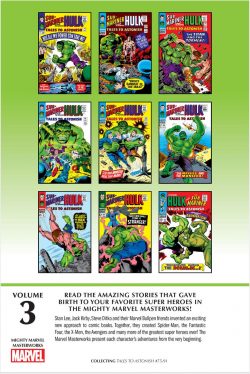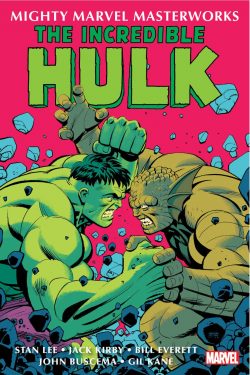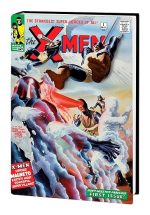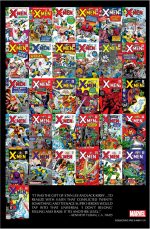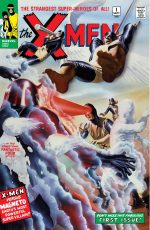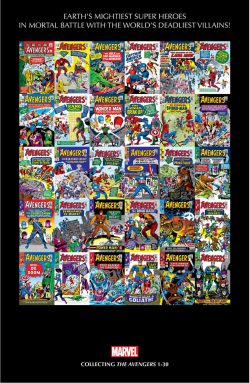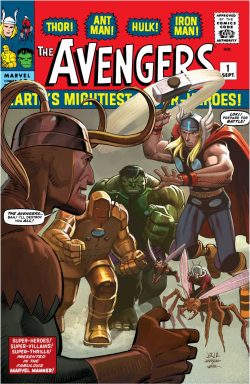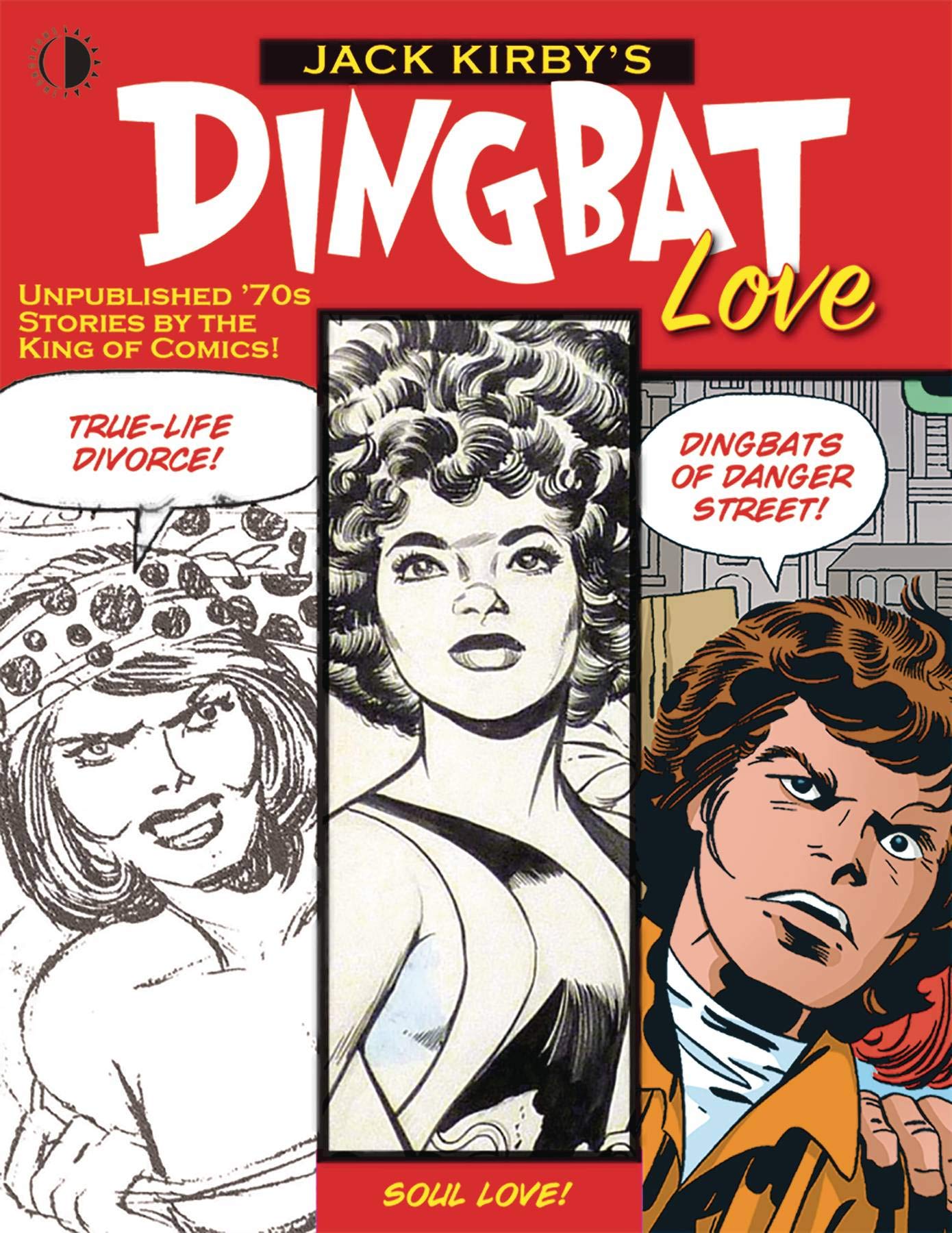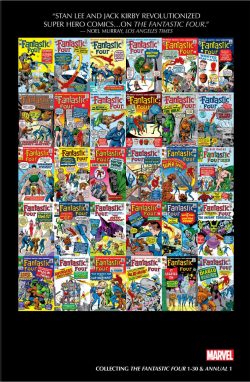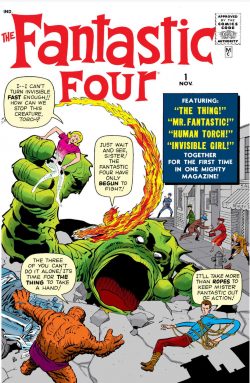

By Stan Lee & Jack Kirby with Chic Stone, Frank Giacoia, Vince Colletta, Sam Rosen, Art Simek & various (MARVEL)
ISBN: ?978-0-7851-8567-3 (HB/Digital edition)
It’s not an international public holiday yet but August 28th is the birthday of Comics’ Greatest Imagineer…
Jacob Kurtzberg AKA Jack Curtiss, Curt Davis, Lance Kirby, Ted Grey, Charles Nicholas, Fred Sande, Teddy The King and others was born on this day in 1917 in New York City, U.S.A. Before dying on February 6th 1994 he did lots of stuff and inspired millions of people. This is some of the most inspirational stuff he did…
In my opinion Fantastic Four #1 is the third most important Silver Age comic book ever, behind Action Comics #1 – introducing Superman – and All Star Comics #3, which invented superhero teams with the debut of The Justice Society of America. Feel free to disagree…
After a troubled period at DC Comics (National Periodicals as it then was) and a creatively productive but disheartening time on the poisoned chalice of the Sky Masters newspaper strip (see Complete Sky Masters of the Space Force), Jack Kirby settled into his job at a small outfit that used to be publishing powerhouse Timely/Marvel/Atlas Comics. He churned out high quality mystery, monster, romance and western material in a market he feared to be ultimately doomed, as always doing the best job possible. That generic fare is now considered some of the best of its kind ever seen. However, his fertile imagination couldn’t be suppressed for long and when the Justice League of America caught readers’ attention it gave him and writer/editor Stan Lee an opportunity to change our industry forever.
According to popular myth, a golfing afternoon led to ever-opportunistic publisher Martin Goodman ordering his nephew Stan to do a title about a group of super-characters like the DC crowd then dominating the marketplace.
The resultant team took those same fans by storm. It wasn’t the powers: they’d all been seen since the beginning of the medium. It wasn’t the costumes: they didn’t have any until the third issue. It was Kirby’s compelling art and the fact that these characters weren’t anodyne cardboard cut-outs. In a real and recognizable location – New York City – imperfect, raw-nerved, touchy outsider people banded together out of tragedy, disaster and necessity to face the incredible. In many ways, The Challengers of the Unknown (Jack’s prototype partners-in-peril for National/DC) had already laid all the groundwork for the wonders to come, but staid, nigh-hidebound editorial strictures of the market leader would never have allowed the undiluted energy of the concept to run all-but-unregulated.
Concocted by “Lee & Kirby”, with inks by George Klein & Christopher Rule, Fantastic Four #1 (bi-monthly and cover-dated November 1961) saw maverick scientist Dr. Reed Richards summon his fiancée Sue Storm, their close friend Ben Grimm and Sue’s teenaged brother before heading off on their first mission. They are all survivors of a private space-shot that went horribly wrong when Cosmic Rays penetrated their ship’s inadequate shielding and mutated them all.
Richards’ body became elastic, Sue gained the power to turn invisible, Johnny Storm could turn into living flame and tragic Ben devolved into a shambling, rocky freak. It was crude, rough, passionate and uncontrolled excitement unlike anything young fans had ever seen before. Thrill-hungry kids pounced on it and the raw storytelling caught a wave of change starting to build in America. It and succeeding issues changed comic books forever.
This second omnibus compendium collects Fantastic Four #31-60, double-sized Annuals #2-4 and and a tale from parody vehicle Not Brand Echh #1 (spanning September 1964 to August1967): issues of progressive landmarks cannily building on that early energy to consolidate the Fantastic Four as the leading title and most innovative series of the era.
Following typically effusive “found footage”, Foreword: A Universal Favorite from Stan – with two more to follow as these many pages turn – precedes the contents of Fantastic Four Annual #2 (September 1964) with Chic Stone inking ‘The Fantastic Origin of Doctor Doom!’ A short (12 page) scene-setter, it momentously details how brilliant Roma (called “gypsy” back then) boy Victor Von Doom remakes himself into the most deadly villain in creation. Ruthlessly surmounting obstacles such as ethnic oppression, crushing poverty and the shocking stigma of a sorceress mother, he rises to national dominance and global status…
Following a batch of villains in ‘A Gallery of the Fantastic Four’s Most Famous Foes!’ (Super-Skrull, Rama-Tut, Molecule Man, Hate-Monger, The Infant Terrible and Diablo) plus pin-ups of Johnny, Sue, Ben, Alicia Masters and Reed, Past informs Present as the ultimate villain believes he has achieved ‘The Final Victory of Dr. Doom!’ through guile, subterfuge and mind-control whereas he has in fact suffered his most ignominious defeat…
Monthly wonderment resumes with #31’s ‘The Mad Menace of the Macabre Mole Man!’ which precariously balances a loopy plan by the subterranean satrap to steal entire streets of New York City with a portentous subplot featuring a mysterious man from Sue’s past, as well as renewing the quartet’s somewhat fractious relationship with The Mighty Avengers…
After the first of every Fantastic 4 Fan Page letter column included for your delectation, the mystery man’s secret is revealed in ‘Death of a Hero!’: a powerful tale of tragedy and regret spanning two galaxies starring the uniquely villainous Invincible Man – who is not at all what he seems…
Supplemented by a glorious Kirby & Stone ‘Prince Namor Pin-up’ and adorned with an experimental photo montage cover from Kirby, FF #33’s ‘Side-by-Side with Sub-Mariner!’ follows, bringing the aquatic antihero one step closer to his own series as the quarrelsome quartet lend surreptitious aid to the embattled undersea monarch against deadly debuting barbarian Attuma after which ‘A House Divided!’ sees the team almost destroyed by power-hungry Mr. Gregory Hungerford Gideon, a Richest Man in the World who still can’t get all he wants…
Following a wry ‘Yancy Street Pin-Up’, #35’s ‘Calamity on the Campus!’ sees the fighting family visit Reed’s old Alma Mater in a tale designed to pander to a burgeoning college fan-base Marvel was then cultivating. Incorporating a cameo role for then-prospective college student Peter Parker, the rousing yarn brings back demon alchemist Diablo and introduces monstrous misunderstood homunculus Dragon Man.
Fantastic Four #36 premiered the team’s theoretical nemeses ‘The Frightful Four’: a group of villains comprising The Wizard, Sandman, Trapster (he was still Paste Pot-Pete here, but not for much longer) plus enigmatic new character Madame Medusa, whose origins were to have a huge impact on the heroes in months to come…
Most notable in this auspicious, action-packed, guest-star-stuffed (all the Avengers and X-Men) but inconclusive duel is the official announcement after so many months of Reed & Sue’s engagement – in itself a rare event in the realm of comic books at that time.
The team spectacularly travel to the homeworld of the shapeshifting Skrulls in #37, seeking justice or vengeance for Sue & Johnny’s recently-murdered father in ‘Behold! A Distant Star!’ They return only to be ‘Defeated by the Frightful Four!’ in #38: a sinister sneak attack and catastrophic clash of opposing forces with a startling cliffhanger that marked Chic Stone’s departure in suitably epic manner.

Frank Giacoia – under the pseudonym Frank Ray – stepped in to ink #39’s ‘A Blind Man Shall Lead Them!’ wherein a suddenly-powerless FF are targeted by an enraged and humiliated Doctor Doom, with only sightless vigilante Daredevil offering a chance to keep them alive.
The saga concludes in ‘The Battle of the Baxter Building’ as Vince Colletta assumes inking duties for a bombastic conclusion dramatically displaying the undeniable power, overwhelming pathos and indomitable heroism of the brutish Thing.
Pausing for another Lee Introduction – ‘When Inspiration Struck’ – a new era of fantastic suspense begins with the first chapter of a tensely traumatic trilogy in which the other (EVIL) FF brainwash the despondent and increasingly isolated Thing: turning him against his former team-mates. It starts with ‘The Brutal Betrayal of Ben Grimm!’, continues in rip-roaring fashion as ‘To Save You, Why Must I Kill You?’ pits the monster’s baffled former comrades against their best friend and the world’s most insidious villains, before concluding in bombastic glory with #44’s ‘Lo! There Shall be an Ending!’
After that Colletta signed off by inking the most crowded Marvel story yet conceived. Cover-dated November 1965, Fantastic Four Annual #3 famously features every hero, most of the villains and lots of ancillary characters from the company pantheon (such as teen-romance stars Patsy Walker & Hedy Wolf and even Stan & Jack themselves). ‘Bedlam at the Baxter Building!’ spectacularly celebrates the Richards-Storm nuptials, despite a massed attack by an army of baddies mesmerised by diabolical Doctor Doom. In its classical simplicity it signalled the end of one era and the start of another…
FF #44 was also a landmark in so many ways. Firstly, it saw the arrival of Joe Sinnott as regular inker: a skilled brush-man with a deft line and a superb grasp of anatomy and facial expression, and an artist prepared to match Kirby’s greatest efforts with his own. Some inkers had problems with just how much detail the King would pencil in; Sinnott relished it and the effort showed. What was wonderful now became incomparable…
‘The Gentleman’s Name is Gorgon!’ premieres a mysterious powerhouse with ponderous metal hooves instead of feet: a hunter implacably stalking Medusa. She then entangles the Human Torch – and thus the whole team – in her frantic bid to escape, and that’s before tmonstrous android Dragon Man shows up to complicate matters. All this is mere prelude, however: with the next issue we meet a hidden race of super-beings secretly sharing Earth for millennia. ‘Among Us Hide… The Inhumans’ reveals Medusa to be part of the Royal Family of Attilan, paranormal aristocrats on the run ever since a coup deposed the true king.
Black Bolt, Triton, Karnak and the rest would quickly become mainstays of the ever-expanding Marvel Universe, but their bewitching young cousin Crystal with her faithful giant teleporting dog Lockjaw (“who’s a Guh-hood chunky Boh-oy?”) were the real stars here. For young Johnny it is love at first sight, and Crystal’s eventual fate would finally season and mature his character, giving him a hint of angst-ridden tragedy to resonate greatly with the generation of young readers who were growing up with the comic…

‘Those Who Would Destroy Us!’ and ‘Beware the Hidden Land!’ (#46 – 47) see the team join the Inhumans as Black Bolt struggles to take back the throne from his bonkers brother Maximus the Mad, only to stumble into the usurper’s plan to wipe “inferior” humanity from the Earth.
Ideas just seem to explode from Kirby at this time. Despite being only halfway through one storyline, FF #48 trumpeted ‘The Coming of Galactus!’ so the Inhumans saga was swiftly but satisfyingly wrapped up (by page 6!) with the entire clandestine race sealed behind an impenetrable dome called the Negative Zone (later retitled Negative Barrier to avoid confusion with the sub-space gateway Reed worked on for years). Meanwhile, a cosmic entity approaches Earth, preceded by a gleaming herald on a board of pure cosmic energy…
I suspect this experimental – and vaguely uncomfortable – approach to narrative mechanics was calculated and deliberate, mirroring the way TV soap operas increasingly delivered their interwoven overlapped storylines, and used here as a means to keep readers glued to the series.
They needn’t have bothered. The stories and concepts were more than enough…
‘If this be Doomsday!’ sees planet-eating Galactus setting up shop over the Baxter Building despite the FF’s best efforts, whilst his coldly gleaming herald has his humanity accidentally rekindled by simply conversing with The Thing’s blind girlfriend Alicia. Issue #50’s ‘The Startling Saga of the Silver Surfer!’ concludes the epic in grand manner as the reawakened ethical core of the Surfer and heroism of the FF buy enough time for Richards to literally save the world with a boldly-borrowed Deus ex Machina gadget…
Once again, the tale ends in the middle of the issue, with the remaining half concentrating on the team getting back to “normal”. To that extent, Johnny finally enrols at Metro College, desperate to forget lost love Crystal and his unnerving jaunts to the ends of the universe. On his first day, the lad meets imposing and enigmatic Native American Wyatt Wingfoot, who is destined to become his greatest friend…
That would be a great place to stop but its only a final pause and third Lee Introduction ‘A Combo That’s Hard to Beat’ before moving on to a tale many fans consider the greatest single FF story ever. Illustrated by Kirby and inked by Sinnott, ‘This Man… This Monster!’ finds Ben’s grotesque body usurped and stolen by a vengeful, petty-minded scientist harbouring a grudge against Reed. The anonymous boffin subsequently discovers the true measure of his unsuspecting intellectual rival and willingly pays a fateful price for his envy…
By now the FF had become the most consistently groundbreaking and indisputable core title and series of Marvel’s ever-unfolding web of cosmic creation: a forge for new concepts and characters at a time when Kirby was in his conceptual prime and continually unleashing his vast imagination on plot after spectacular plot as Lee scripted some of the most passionate superhero sagas that Marvel – or any publisher for that matter – has ever seen.
Both were on an unstoppable roll, at the height of their creative powers, and full of the confidence that only success brings, with The King particularly eager to see how far the genre and the medium and even society could be pushed…
Without preamble the wonderment recommenced with an actual cultural revolution as a new unforgettable character debuted. ‘The Black Panther!’ (#52, cover-dated July 1966) was an enigmatic African monarch whose secretive kingdom was the only source of a vibration-absorbing alien metal. Mineral riches had enabled him to turn his country into a technological wonderland and – bold and confident – he lured the quartet into his savage super-scientific kingdom as part of an extended plan to gain vengeance on the murderer of his father. He was the first black superhero in American comics.
After battling the team to a standstill, King T’Challa reveals his tragic origin in ‘The Way it Began..!’, therby also introducing sonic supervillain Klaw. In the aftermath Johnny and tag-along college roommate Wyatt embark on a quest to rescue Crystal (still imprisoned with her people behind an impenetrable energy barrier in the Himalayas). The journey is paused when they discover the lost tomb of Prester John in #54’s‘Whosoever Finds the Evil Eye…!’ and almost perish in devastating, misguided combat…
For aiding the FF against Galactus, the Silver Surfer was imprisoned on Earth by the vengeful space-god. The brooding, perpetually moralising former herald had quickly become a fan-favourite and his regular appearances were always a guarantee of something special. ‘When Strikes the Silver Surfer!’ sees him in uncomprehending, brutal battle with Ben Grimm, whose insecurities over his sightless girlfriend explode into searing jealousy when the gleaming skyglider comes calling, before business as unusual resumes when ‘Klaw, the Murderous Master of Sound!’ ambushes the team in their own home in #56.
Throughout all the stories since their imprisonment, a running sub-plot with The Inhumans had been slowly building, with Johnny & Wyatt stuck on the other side of the Great Barrier: wandering the Himalayan wilds whilst seeking a way to liberate the Hidden City.
Their quest led directly into spectacular battle yarn ‘The Torch that Was!’: lead feature in the fourth FF Annual (November 1966) wherein The Mad Thinker recovers and resurrects the original Human Torch (in actuality world’s first android and a major star of Timely/Marvel’s Golden Age). The reawakened revanant is soon reprogrammed to destroy the flaming teenager who succeeded him and the blistering battle briefly reunites the entire team, leading into an epic clash with their greatest foe…
Fantastic Four #57-60 is Lee & Kirby at their sublime best, with unbearable tension, breathtaking drama and shattering action on all fronts as the most dangerous man on Earth steals and empowers himself with the Silver Surfer’s cosmic forces, even as The Inhumans at last win their freedom and we learn the tragic secret of mute Black Bolt in all its awesome fury.
It begins with a jailbreak by Sandman in #57’s ‘Enter… Dr. Doom!’, escalates in ‘The Dismal Dregs of Defeat!’ as Doom tests his limitless stolen power and crushes all earthly resistance; builds to a crescendo in ‘Doomsday’ with the heroes’ utter defeat and humiliation before culminating in brains and valour saving the day – and all humanity – in truly magnificent manner in ‘The Peril and the Power!’

After all the heartstopping action and suspense the affair ends for the present on a comedic note, with a pertinent parody from spoof title Not Brand Echh, opening with #1 (August 1967) and Lee, Kirby & Giacoia’s reassessment of Doom’s theft of the Power Cosmic in ‘The Silver Burper!’…
Art lovers and history buffs can also enjoy a boundless hidden bounty at the end of this volume as we close with fascinating freebies in the form of essays ‘Fantastic Four’s Golden Year’ by Roy Thomas, ‘From This Day Forward: How Marriage Changes Everything (Even for the FF)’ by Jon B. Cooke, ‘Wonderment Aplenty’ by Mark Evanier, ‘What’s in a Name’ by John Morrow and ‘The Start of a Revolution’ by Reginald Hudlin, all supported by visual treats including numerous house ads, initial designs for Coal Tiger (who evolved into the Black Panther), Kirby & Sinnott’s unused first cover for FF #52, an unmodified version of the cover for #38, bolstered by the covers for FF reprint titles Marvel Collectors’ Item Classics/Marvel’s Greatest Comics #1-43 and Marvel Triple Action #1-4 by Kirby, Gil Kane, John Buscema, Sal Buscema, Jim Starlin and Kirby augmented by original art pages and Ladrönn’s cover for the 2007 FF Omnibus #2 edition.
Epic, revolutionary and unutterably unmissable, these are the stories which made Marvel the unassailable leaders in comics fantasy entertainment and they remain some of the most important superhero stories ever crafted. The verve, conceptual scope and sheer enthusiasm shines through on every page and the wonder is there for you to share. If you’ve never thrilled to these spectacular sagas then this book of marvels is the perfect key to another – far brighter – world and time.
© 2022 MARVEL.
And since So Many Others are already talking of Yule fuel…
Win’s Christmas Gift Recommendation: Total Entertainment Perfection… 10/10








